Different Drums: Oberlin’s Creativity and Leadership Project
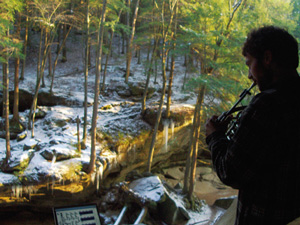
James Scott Chowning ’08 improvises in the sandstone caves of Hocking Hills, Ohio, for his C & L project with Evan Adams ’09.
About three hours south of Oberlin, deep in the heart of Ohio’s picturesque Hocking Hills, the sound of a solo French horn rings out over the waterfalls, sandstone, and hemlocks. It is winter, and snow covers the ground in patches. Inside Old Man’s Cave, a recess in the rock perched 70 feet above the ground, horn performance major James Scott Chowning ’08 looks out over the woods, playing a meditative improvisation. Nearby, Evan Adams ’09, a philosophy major in the College, hunches over a laptop, evaluating, recording, and manipulating the sounds as they reverberate off the cave walls and out into the forest.
The scene might be more Henry David Thoreau than Bill Gates, but Chowning’s and Adams’ project, focused on understanding the relationship between space and sound, was made possible by Oberlin’s new entrepreneurship project, Creativity & Leadership (C & L). Launched with the support of $1.1 million in grants from the Burton D. Morgan and Ewing Marion Kauffman foundations, C & L takes a broad view of entrepreneurship-encompassing both business and artistic ventures-and provides financial, logistical, and creative resources to fuel the innovative ideas of Oberlin students.
C & L turns the standard business-school approach to entrepreneurship on its head. Rather than laying out a prescribed course of study, C & L offers a number of different learning opportunities designed to fit students’ needs and support the implementation of their projects, according to Associate Dean for Academic Affairs Andrea Kalyn, director of the Creativity & Leadership project. “We fund creative student ventures, both short term and longer term, support internships, provide opportunities for students to be mentored by entrepreneurial Oberlin alumni, and offer classes varying from grant writing to accounting to audio engineering,” she says.
The approach makes sense for Oberlin, says Lauren Abendschein ’07, who studied French horn in the Conservatory and politics in the College, and whose current job in Oberlin’s Office of Career Services is to help students take full advantage of C & L’s resources. “There’s such a foundation for entrepreneurship at Oberlin-there just wasn’t a framework until now,” she says. For the Conservatory in particular, it’s a natural fit.
Investing in Imagination
A fund dedicated to Conservatory students, the Conservatory Initiative Grants Supporting Imagination and Excellence (CIGSIE), is part of the spectrum of C & L’s offerings. CIGSIE provides innovative, motivated, and prepared Oberlin Conservatory and double-degree students the opportunity to develop and implement imaginative artistic projects during winter term, awarding grants of as much as $6,000 for up to three student projects.
It was this fund that made Chowning’s and Adams’ project in the forests of Hocking Hills possible. Their idea, says Assistant Professor of TIMARA Peter Swendsen ’99, grew out of the Advanced Electroacoustic Music class they took together. Chowning had developed tools to measure the overtone series produced by his horn; Adams focused on analyzing the unique resonant properties of different nontraditional spaces. C & L provided a crucial last piece of the puzzle: the funding to build a portable system they could use anywhere, outdoors and in, to combine their work and put their ideas into practice.
In addition to sites in the Hocking Hills, the two visited a skateboard park full-pipe in Athens, Ohio, a highway underpass in Cleveland, and the expansive Jones Field House on the Oberlin campus, where they used the software they had developed to understand and enhance their performances. More than simply experimenting with novel spaces, says Swendsen, they created a partnership, a “duet with the space they were in.”
Their results have been noticed. According to Swendsen, when composer and former Oberlin faculty member Pauline Oliveros saw the video and heard the recordings of the project, available on the Creativity & Leadership web site at www.oberlin.edu/creativity, she was “very impressed and pleased.” Both students hope to do more with what they have learned, continuing to collaborate.
This type of project, says Kalyn, is exactly what C & L is uniquely equipped to support. “Our students are naturally creative and entrepreneurial,” she says. “Creativity & Leadership simply gives them license to experiment, to innovate, and to do so while they are still students, so that later they can draw upon those experiences while they build their careers.”
Bach to Basics
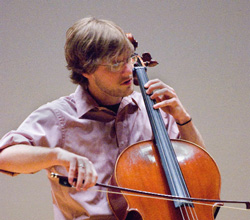
Cellist Steuart Pincombe ’09 used his CIGSIE (Conservatory Initiative Grants Supporting Imagination and Excellence) to prepare a unique historical interpretation of Johann Sebastian Bach’s suites for solo cello.
CIGSIE projects can take many forms. Another grant recipient this year, cellist Steuart Pincombe ’09, used his CIGSIE to prepare a unique historical interpretation of Johann Sebastian Bach’s suites for solo cello. He recorded three of the suites over winter term and embarked on a six-city concert tour in February 2008, followed by a recording of the remaining three suites.
Pincombe’s project sought to realize Bach’s true intent for the performance of the suites. He was inspired by the detailed handwritten bowings and articulations found in a copy of Bach’s manuscript that had belonged to Anna Magdalena Bach, his wife. Pincombe used a facsimile of Anna Magdalena’s score as his historical source, painstakingly copying each mark into his own edition.
Remaining faithful to these articulations, he developed an interpretation of the suites that he performed in venues throughout the Midwest-Springfield and Kansas City, Missouri; Oberlin, Ohio; and Bloomington, Indiana-as well as in Tulsa, Oklahoma, and New York City. In the end, he found that his historically accurate approach also resonated with audiences.
“This was a new idea for many people, and they really got to see how it allowed Bach to speak, as opposed to just the performer,” Pincombe explains. “I was able to bring together two types of audiences”-early music devotees alongside casual listeners-“and be a mediator for Bach’s music.” The choice to perform on modern cello was a deliberate one, he wrote in a blog post about his New York performance. He intended to demonstrate how a “historically informed approach . will enhance even modern playing.”
School of Rock?
As schools around the country slash budgets for arts education, Nathaniel Gelb ’08 took music education to the road this summer, supported by an $8,000 C & L fellowship grant. Rockstarz Clinic reaches campers who might not otherwise have the chance to learn music by bringing camps a traveling team of teachers, including Conservatory students Nate Levin ’08 and Tom Fosnocht ’09. On this summer’s “trial tour,” Gelb brought the crew to boys’ and girls’ camps in Maine to perform, teach songwriting, and even record campers’ original tunes. A sure sign of success: they’ve already been invited to return next summer.
Using electric guitars and deejay equipment as his teaching tools, Gelb wanted to reach kids who might not think of themselves as the orchestral type. “Our goal was to create interest at a young age,” he says, building, in just a few short days, an appreciation for music that might last a lifetime.
Tools of the Trade
In addition to project-based funding, C & L has revitalized the Conservatory’s approach to classroom-based career education. In Professional Development for the Freelance Artist, Clinical Assistant Professor of Flute Kathleen Chastain teaches a packed few months of do-it-yourself marketing, negotiating, networking, and more-all skills a Conservatory graduate can use to support a freelance career. Touring for Musicians, taught by Professor of Viola Peter Slowik and Assistant Dean Gloria Kim ’02, offers pointers on planning, from repertoire to contracts to insurance. Two new courses for 2008–09, developed by Associate Professor of Computer Music and Digital Arts Tom Lopez ’89, focus on the increasing importance of technological fluency. A music notation course teaches essential skills for publishing musicologists and composers alike, and another, in audio recording, uses a hands-on approach to teach students the basics of recording, editing, and distributing their own music.
Calling All Entrepreneurs
In February, a two-day symposium, “Inventing the Future: Entrepreneurship at Oberlin,” celebrated the launch of Creativity & Leadership, bringing together entrepreneurs from all fields, many of them Oberlin graduates. Dr. Jonathan Merril ’84, co-founder and CEO of Astute Technology, gave students tips on how to know when the time is right for their innovation. Target’s Vice President of Product Design Michael Alexin ’79 inspired students to innovate within existing parameters, advice that could be applied just as easily to orchestras as to pharmacy packaging.
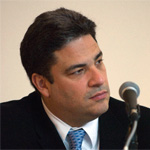
David H. Stull
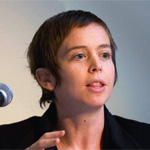
Claire Chase ’01
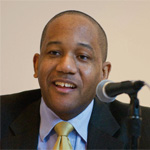
Aaron Flagg

Charles Hamlen
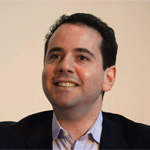
Bill Palent ’91
In “The Musician as Entrepreneur,” panelists shared success stories and encouraged students to create opportunities for themselves.
Panel discussions on the second day of the symposium delved more deeply into specific areas. One of them, titled “The Musician as Entrepreneur: The Passionate Pursuit of Innovation, Engagement, and Creativity,” was moderated by Dean of the Conservatory David H. Stull and brought together Claire Chase ’01, Executive Director of the International Contemporary Ensemble (ICE); Aaron Flagg, Executive Director of the Music Conservatory of Westchester; Charles Hamlen, Founding Director of Classical Action: Performing Artists Against AIDS; and Bill Palant ’91, Vice President and Artist Manager at IMG.
“If you are a musician,” said Stull at the outset, “you’re really automatically an entrepreneur.” Luckily for current students, he continued, this is a great time to be both. “More might be possible than ever before for young musicians.”
Claire Chase emphatically agreed. “We have unprecedented freedom. We don’t have to have a record company. We don’t have to have an agent. You really can build your own career.” Chase’s own path serves as a case in point.
After graduating from Oberlin, Chase recalled, she was suddenly faced with the big question: what to do with her life, post-conservatory? A grant from the Theodore Presser Foundation enabled her to mount her first concert, in Oberlin’s Warner Concert Hall. That concert, she said, “became the touchstone for everything that has happened with ICE.”
Seven years later, ICE has presented more than 300 world premieres, with a busy performance schedule of some 60 concerts each year at venues across the United States. In 2005, the group won an award for adventurous programming from Chamber Music America and the American Society of Composers, Authors, and Publishers (ASCAP).
“You create opportunity for yourself,” she explained to students at the February panel discussion. “It’s becoming not just a strategy, but a way of life for our generation.”
An entrepreneur’s way of life is not always easy, though. “It’s important to say that failure can happen,” Bill Palant told students at the symposium. It’s part of our job as educators, he said, to “prepare students for the career challenges” that will come their way.
In fact, the opportunity to test ideas and confront challenges is an important part of the value of the C & L curriculum. Sometimes, says Kalyn, students will decide those challenges are simply more than they are ready to take on; recognizing that also counts as a success and can inform a student’s professional path.
You Say Goodbye, I Say Hello
This year’s third CIGSIE grant winner was an Oberlin student band composed of both Conservatory and College students. The Pianos used their grant to fund an intensive weeklong East Coast tour in January to support their EP, hello. The CD they produced was a testament to the band’s unique sound, creative original songwriting, and high level of musicality. After completing the tour, however, the members decided that life as a band was not for them.
The experience was valuable all the same. “I made so many connections,” says Jordan Goldstein ’09. “I learned so much about being in a band and about being a leader,” skills he’ll bring to his next project. He’s full of ideas about what that might be.
In its first full year, C & L has already funded two tours, three recording projects, and numerous internships for students; supported the development of new classes in touring, recording, music notation, and life as a freelance musician; and, through the fellowship, provided the seed money to launch an innovative new music education business. Organizers like Kalyn, however, say this is only the tip of the iceberg. Creativity & Leadership, she says, should be “woven throughout the campus” as an integral part of Oberlin life.
Bang on That Can
One student poised to take advantage of all that the program has to offer is Katie Gluck ’10. A double-degree student majoring in economics and classical saxophone performance, Gluck says that after attending the C & L symposium session “The Musician as Entrepreneur,” she was enthusiastic about the idea of starting her own venture.
“If you are a musician, you’re really automatically an entrepreneur.”
Motivated by the ideas she had heard, Gluck started thinking about how she could combine her love of music with her economics background and came up with a creative way to fund live performances that wouldn’t rely on ticket revenue. “I did the whole clich�d ‘writing it down on a napkin’ thing,” she says, and talked enthusiastically about the idea with whoever would listen. Inspired by the Depression-era New Deal program, Gluck’s business would hire musicians to perform at modest wages, guaranteeing a consistent income stream for them and free performances for the public. Performances would be funded by a revenue source other than ticket sales, erasing financial barriers for audiences. Napkin scrawls in hand, she embarked on a “fact-finding mission.”
Her first stop, in summer 2008, was a Creativity & Leadership-funded internship with Bang on a Can, an ensemble, organization, and record label cofounded by Distinguished Visiting Professor of Composition David Lang [see Pulitzer Prize-Winning Composer Joins the Faculty] and dedicated to creating, performing, and recording contemporary music. In a time of widespread record store closings, massive profit declines, and rampant layoffs, says Gluck, “I wanted to see how one of the most avant-garde labels is surviving.” Working and performing alongside composers, musicians, and administrators, she gained experience with a wide range of arts management considerations, from concert production to funding to audience development. “I asked a lot of questions,” she says, all the while picking up experiences that could help her make her own venture a success.
This fall, Gluck enrolled in Creativity and Leadership: An Introduction to Entrepreneurship to pick up more skills and background. Her experience at Bang on a Can taught her that staging concerts is a big undertaking and that she’d do best to start small. So, when she departs for a semester of study in Italy in spring 2009, she plans to stage a few small-scale concerts with Conservatory students and local musicians there to begin testing her idea. She’s already been in touch with a few people in Italy who have agreed to help. She also found a mentor to help her get a handle on the potential financial pitfalls.
For Gluck, Creativity & Leadership has served as the perfect link between her academic interests and her career aspirations post-Oberlin. Having a good idea is an important start, but often it’s not enough. Add the support for that idea, she says, and then “it can really take off.”
Zachary Lewis contributed to this article.
